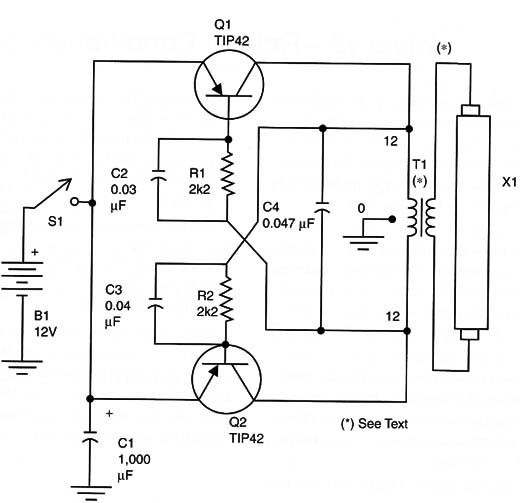A powerful inverter powered from a 12-volt car battery is shown in Figure 1. This circuit can drive lamps up to 20 watts and uses two transistors in a push-pull configuration.

The transistor must be mounted on a heatsink because the current drain for the circuit reaches more than 1 amp in some cases. The output power will depend on many factors.
One of the factors that determines the output power is the transformer.
Currents that range from 500 milliamps to 1 amp are recommended. As high is the current is, more power can be obtained for the lamp.
You will want to experiment with the values of many of the circuit’s components to find the best performance, mainly to match the transformer’s characteristics with the circuit. The values for resistors R1 and R2, for instance, can range between 470 and 4.7 k Ω, and C2 and C3 can range between 0.01 and 0.22 µF.
C3 can also be replaced by units between 0.047 and 0.22 µF.
Additionally, the power source is a 12-Volt car or motorcycle battery, and it is important to say that this circuit will power lamps up to 40 watts, but they will not glow at their total power.
Pulsed Light
Experiments with pulsed or stroboscopic lamps can also be used to attract insects. The circuit shown in the stroboscopic lamp in this section is suggested for use in a fluorescent lamp.
Incandescent Lamps
Although incandescent lamps, due to their spectral characteristics, are not that useful for attracting insects, they can also be used. It is up to the reader to discover if white or color lamps are more efficient for this task. Black incandescent lamps are also available but they are very poor UV sources, as suggested by the spectral response.
The advantage of this source is that it can be plugged directly into the AC power line without the need for any other device (only the on/off switch, if desired). Incandescent black light lamps from 60 to 100 watts can be used.
Other Experiments
The reader can probably imagine many other applications linking a light source (visible or UV) with a living being. For instance, it is well known that many types of bees are blind to the color red, and thus they cannot see any source of red light.
If you place bees in an area filled only with red light, for them the room will be completely dark. Consequently, they will crash against walls and objects when flying.
An interesting experiment would be to see how insects and many other living beings (fish and plants) react under light sources of different wavelengths (colors). The reader could use not only white and UV lamps, but different colored lamps.
Q1, Q2: TIP42 - PNP silicon power transistor
T1- Transformer (see text)
R1, R2 - 2.2 k Ω x 1/2 W - resistor, red, red, red
C1 - 1,000 µF x 16 V electrolytic capacitor
C2, C3 - 0.01 µF ceramic or polyester capacitor
C4 - 0.047 µF ceramic or polyester capacitor
S1 - On/off switch
B1- 12 V battery (see text)
X1 – Fluorescent lamp – see text




